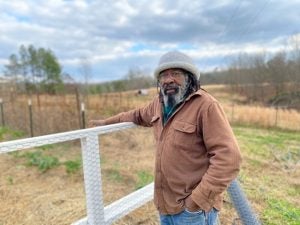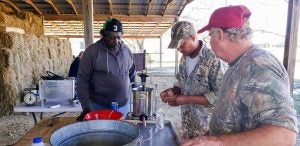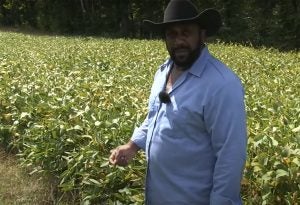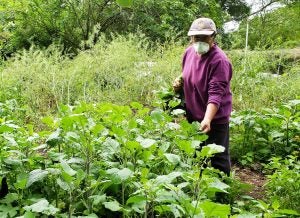2020 saw a national reckoning on American race relations, and the history of Black farmers became a key piece of the puzzle
Woven into the fabric of a tumultuous 2020 — which included a deadly and fast-moving pandemic and a fiery presidential election — the United States faced a reckoning on race relations. The killings of Breonna Taylor in March by law enforcement and of George Floyd while being aggressively detained in police custody in May were two of the largest trigger points, igniting nationwide protests about police accountability, the treatment of Black Americans, and the marginalization of a large segment of the population.
People took to social media to “lift Black voices” — an effort to afford Black Americans the opportunity to speak about their lives and to make their experiences a more visible part of the U.S. tapestry. It also motivated individuals and companies to issue statements condemning structural racism, as well as be cognizant of more overt acts of bigotry.
“We strongly oppose racial discrimination and believe just treatment by law enforcement is essential to maintain public trust and to uphold the Constitution./ We also believe we have a responsibility across our society to honestly examine, identify, and address racism./ That includes looking within our own organizations.” — American Farm Bureau Federation
“There is systemic racism in our country. For years, Soylent has been trying to fight hunger, poverty and homelessness in an effort to support communities that face these challenges. We continue to stand firm with this commitment. However, we realize that THIS IS NOT ENOUGH.” — Soylent
“Hatred and discrimination have no place in our society. … Today, we’re pledging $1M to the NAACP Empowerment Programs to fight against racial inequality.” — John Deere
Black agriculturalists, specifically, have faced challenges throughout U.S. history. Agrarian America was built on the manpower of slavery — oppressive, inhumane, and exploitative. For decades, Africans and their descendants were denied the opportunity to share in the proceeds of sprawling farms and the privileges afforded to wealthy White landowners.
Even after the Civil War came to a close in 1865, Blacks across the South who were interested in pursuing agriculture were denied access to the newly created public land-grant universities, only inching toward more equal footing a quarter century later with the Second Morrill Act, which required the former Confederate states to establish sister universities for Blacks.
Discriminatory practices continued to be prevalent for generations, and federal- and state-level legislation that purported to assist minorities in agriculture too often lacked any real difference-making characteristics.
“The past truly is connected to the present,” said Richard Morris, Urban Agriculture Collective Farm and Foodroots Program Director for Cultivate Charlottesville. “The biggest challenge to success for Black farmers is that in 156 years since the end of the Civil War, America has yet to deliver on the promise of racial equity and fairness.”
The past several months, however, have ushered in a new recognition of the history of civil rights in America and the value of real action when coupled with the pledges of solidarity being projected across the digital landscape. In 2020 and onward into 2021, more and more eyes began paying close attention to who would step up and put substance behind their stated support for equality.
John Deere, the largest manufacturer of farm equipment in the United States, immediately took the lead in the agricultural space. In mid-June, the company donated $1 million toward programs at the NAACP that train, educate, and advocate for civil-rights policy. Deere also offered matching donations to the social justice organizations its employees opted to donate to.
“I wrote an impassioned letter to my employees, as a Black man who has experienced some of this, about how in this environment that we’re in, how difficult this is,” Marc Howze, Group President for Lifecycle Solutions and Chief Administrative Officer at Deere, said in an interview.
Howze’s leadership helped put Deere on a broader trajectory within agriculture’s Black communities, one that would inspire new partnerships and zero in on an issue to rally around.
While criminal justice reform, education, welfare, and access to financial capital are all issues that society needs to address to aid minorities, one of longest-running tragedies affecting Black farmers and Black-owned land is that of heir’s property, a complex issue that involves land passed from generation to generation without standardized legal paperwork, often the result of an ancestor who died without a will. More than 60 percent of Black farmers currently operate on heir’s property.

Last year, with Howze’s guidance, Deere sought an enterprise to pour its resources into — and heir’s property rose to the top of the list. The company embraced some of its long-standing allies to announce a new minority coalition last September, with the hope of helping to address what has become the leading reason that Black agriculturalists have lost land over the past century.
In 1910, Black people owned about 16 million acres of land in the U.S.; today, it’s less than 5 million. And that’s an improvement from the 1980s, when the number had been closer to 3 million acres. About 95 percent of today’s farmland owners are White and just 0.52 percent of the total farmland in the United States is owned or operated by a Black farmer.
Issues such as heir’s property are central to Black farmers and ranchers. Because of such limitations, many Black growers are unable to adequately leverage the equity in their land.
“This is a glaring problem and an intended consequence of a system designed to dispossess Black people of wealth, and Black farmers of land,” said Marla Karina Larrave, Political Education Director for HEAL Food Alliance.
The new coalition led by Deere, called LEAP (Legislation, Education, Advocacy, and Production Systems), is intended to collectively address priority legislation, expand educational and advocacy opportunities, and ensure access to tools and technology that farmers need to successfully navigate advanced production systems.
“Fundamentally, a farm is the No. 1 asset a farmer has. And here you have what’s been estimated as 60 percent of Black farmers who have farms that they don’t have clear title on. They can’t leverage that land for loans, they can’t use it as collateral, they’re not eligible for some federal assistance,” Howze said. “We asked ourselves, ‘How do we provide more value to customers and unlock value that’s there?’”
Deere has a history of partnering with the National Black Growers Council, Minorities in Ag, Natural Resources and Related Sciences (MANNRS), and the Thurgood Marshall College Fund — the latter of which works on public policy recommendations that impact historically Black colleges and universities (HBCUs) and predominantly Black institutions (PBIs). Howze was a past board member of the fund, while Collis Jones, Deere Vice President for U.S. Policy and Strategy, is a current board member. All of these organizations and others were listed as partners in press materials over the summer when the $1 million NAACP donation was announced, and all have joined in the LEAP coalition.
“We have a unique opportunity to work with small businesses and access to capital, specifically with Black farmers. So, the idea was to focus there and figure out how we can be impactful,” said Howze, whose own family in Alabama has seen the impact of heir’s property.

Adding heft to the initiative was a partnership that Deere announced in January with the Federation of Southern Cooperatives, the oldest and most respected Black farmer organization. The federation assists limited-resource farmers, landowners, and cooperatives across the South with business planning, debt restructuring, marketing expertise, and a whole range of other services to ensure the retention of land ownership and cooperatives as a tool for social and economic justice.
The federation doesn’t piggy-back on cultural trends, said Cornelius Blanding, its Executive Director. “What we do works. We were born out of the civil rights movement — we have withstood manmade and natural disasters,” he said.
The decision to partner with Deere wasn’t something that was taken lightly or done impulsively. Deere’s footprint and reputation throughout generations of agriculturalists carry weight and attract more stakeholders to the federation’s mission. Blanding said that, in a historic context, Deere’s long-term commitment, its dedicated staff person, and its focus and emphasis on the federation’s mission goes beyond paying generic lip-service to a movement — it’s laying a foundation for success.
Deere said it will provide key investments in the federation’s Legal Internship Program, which gives law students a 12-week internship opportunity to assist licensed attorneys with land tenure and heir’s property issues across the Southeastern United States, where heir’s property is most prevalent. Deere will also put money toward the National Heirs Property Conference, which is the federation’s largest annual heir’s property event. Both pieces are five-year commitments.
The federation has “been working in this space for well over 50 years, and they are the premier organization with a demonstrated track record of success on saving and protecting and expanding Black family land ownership,” Howze said.
When race is discussed in agriculture, one of the most commonly asked questions is why Black farmers need their own group and why broad-based organizations such as the American Farm Bureau Federation aren’t enough for them. Yet when you think that today there are associations that focus on women in ag, veteran farmers, and commodity producers such as corn growers, it seems almost ridiculous to deny the need for and appeal of organizations specific to Black farmers.
Headlines and 24-hour TV news cycles have helped to amplify discussions of race in America. White America was being urged to listen to the Black community and to make a sincere effort to see the world through their lens. It’s more than just a rally cry of Black Lives Matter, it’s understanding why these protests are happening, it’s acknowledging Black burnout, it’s seeing the negative neighborhood impacts of a system long set against people of color.
“At the outset, White settlers designed and implemented a system that stole the labor, skill, and wealth of Black people,” said Larrave at HEAL Food Alliance. “This is the first challenge that informs all other challenges facing Black communities today.”
In recent months, White people have been pressed to be uncomfortable with new information of what it’s like to be Black — not to embrace it or pat themselves on the back for “sharing” in that discomfort, but to let it painfully and purposefully gnaw at them.
One essay last year on race said, in part: “I don’t want your opinions or thoughts./I want you to listen to the Black experiences you’ve chosen to forget. …
“I don’t want your passive Twitter likes./I want you to follow Black tragedies as much as you follow Black trends.”
It means knowing that 99 percent of the subsidies provided to farmers linked to the trade war with China went to White farmers, or that a decade ago, the U.S. Department of Agriculture actively misled the public on its diversity efforts.
“To understand the past 15 years you have to understand the 141 years that preceded them,” Morris said. “The Civil war ended in 1865, and not long after, so too did the promise of land resettlement for people formerly enslaved. This was a missed opportunity for equality that impacts Black people today. It took another 100 years for African-Americans to achieve legal parity with the passage of the Civil Rights Act in 1965. But that parity did not end widespread discrimination.”
He urges White families to advocate for more diverse farmers markets, seek out Black businesses online, and expand their social networks to allow Black people to tap into those opportunities that are never formally publicized. These are networks where Black farmers have long been underrepresented.
Leaders in the Black community argue that larger-scale food systems often work against minority farmers and small-scale producers. The concern is that some lobbying interests can undermine efforts to advance regional economies and local communities, as well as create barriers to healthy ecosystems in Black neighborhoods.
If John Deere’s newest effort is helping to raise awareness of Black communities and of a central Black justice issue that many in America may not be familiar with, then why is the leadership of the National Black Farmers Association calling it an “egregious corporate misstep” and the creation of the LEAP coalition “offensive”? It is a testament to the complexity of racial perspective, both within an industry and beyond its invisible walls.
John Boyd Jr., a fourth-generation farmer and founder and president of the NBFA, has spent decades advocating on Capitol Hill and across America’s farmlands for the rights of minority farmers, and he understands marginalization, disrespect, and struggle more than most.

Boyd said his goal is to help the Black men and women in agriculture, something he’s been doing for decades. In the 1990s, Boyd helped ignite a lawsuit against the USDA over the agency’s treatment of Black farmers (Pigford v. Glickman), and he was influential in writing crucial legislation to give Black farmers financial compensation and a larger platform to voice their concerns. His organization today is built on outreach, advocacy, and technical assistance to socially disadvantaged and limited-resource farmers.
In early September, he called upon the 116,000-member NBFA to boycott John Deere equipment, a move that Howze admits was “surprising.”
For Deere to bring in all of these minority-centric organizations into the LEAP coalition and not include NBFA, which Boyd says does a lot despite having little funding, “I see this as a bully tactic,” and a way to deflect attention from the calls for a boycott, Boyd told AGDAILY. (The LEAP coalition was announced a week after the call for a boycott began.)
On the surface, it seemed Boyd took issue that Deere didn’t set up a booth at the 2019 NBFA annual conference, stating that minority farmers who were customers of Deere wanted the opportunity to see the newest innovations and technology in green paint (Deere was a $5,000 financial sponsor and one of three ag-related businesses showcased in sponsorship posts on social media). About 700 people attend the conference annually.

“We’ve been after them for 25 years to display equipment. Black farmers need the same technology and cutting-edge tools, and implements and tractors as anybody else to compete,” Boyd said. “I’ve been to other conferences, and I’ve seen them display equipment.”
Yet the deeper layers to Boyd’s call to action against Deere didn’t lie primarily in the 2019 conference, where he accused Deere of “snubbing Black farmers.” Instead, it was rooted in the fact that while the NBFA benefitted from the $5,000 given that year, a non-farm related organization such as the NAACP literally got 200 times that amount from Deere.
“You give the NAACP $1 million, and you give the organization who is buying your tractors and buying your parts $5,000, and you can’t see something troubling with that?” Boyd said.
At least some NBFA members spoke up to support the boycott. An email, which was provided to AGDAILY, from a former Marine sergeant was sent to dozens of Black Lives Matter chapters and other organizations around the country. In it, the veteran spoke passionately of supporting Boyd and getting other prominent figures involved.
The email channels many racial and social issues — including redistribution of wealth, farm suicides, and educational outreach — that capture how lasting the tensions have been.
Yet despite these events, Boyd said he and his organization crave partnerships with corporations, such as Deere, to help himself and other Black farmers be competitive in agriculture.
“We need some clarification and accountability that would lead to all-inclusiveness. You can’t just come out and create a new group, and you haven’t included the individuals who raised all of the issues,” he said. “This is about treating everybody with dignity and respect. And what they did by forming that group is the total opposite. It’s offensive.”
Boyd’s words lingered for months after the announcement of the LEAP coalition, as anticipation grew about what step LEAP was going to take first and whether logistics such as a website and other outreach strategies got set up. In November, Deere hired a LEAP manager, Tharlyn Fox, who was to steer its minority-related initiatives.
Deere is not publicly releasing how much financial support it is committing to the LEAP coalition, only to say that it involves a multi-year, multi-million dollar investment. The company said recently that it is funding three Thurgood Marshall College Fund internships to provide legal support to Black farmers with heir’s property issues. Other aspects of LEAP’s mission appear to have yet to move forward.
And while the financial impact of Boyd’s call for a boycott remains to be seen, the damage to the social justice movement may have bubbled to the surface. His perspective further lays bare the varying needs, goals, and strategies of a disparate agricultural landscape, where stakeholders and the well-intentioned often don’t see eye to eye — and the ground-level reality of the industry doesn’t get the voice it deserves … or needs.
There’s no singular remedy to the problem of institutional racism, and that leaves various factions often working simultaneously with — but independently of — one another.
The awareness of institutional racism across the country found its way to the highest levels of government in late 2020. U.S. Sen. Cory Booker spearheaded a bill, called the Justice for Black Farmers Act, that sought to “address the history of discrimination against Black farmers and ranchers, to require reforms within the Department of Agriculture to prevent future discrimination, and for other purposes.”
The measure would not only initiate the study of historical and continuing discrimination by the USDA against Black farmers and ranchers, but also put tens of millions of dollars into heir’s property efforts, while ultimately transferring more land back into the hands of Black farmers, which at 50,000 people, number only a twentieth of what they did a century ago.
“From the beginning, even the most enterprising Black landowners found themselves fighting a war of attrition, often fraught with legal obstacles that made passing title to future generations difficult,” as described in a 2019 article of The Atlantic titled This Land Was Our Land.
The Justice for Black Farmers Act would, in essence, use the tools of the wealthy to help out people who haven’t been equitably assisted for generations, while helping to secure a future for the younger crop of farmers and ranchers.
Under the bill, up to 32 million acres would move to Black ownership over the coming decade — “nearly seven times the 4.7 million acres now in Black farms,” according to reporting by Successful Farming.
As tangible steps are being taken by companies such as John Deere, advancement of the Justice for Black Farmers Act stalled almost as quickly as it was introduced, being kicked to the Committee on Finance, where it idled. There was concern over its ability to succeed in Congress, but things shifted recently when the measure was again introduced in the Senate on Feb. 8, after the Biden administration was installed.

In addition to granting land, the bill is intended to create educational opportunities for aspiring farmers, such as a Farm Conservation Corps to help socially disadvantaged youth prepare for a career in agriculture, and by providing additional funding for HBCUs that have agriculture programs.
“Young people are capable of looking at the history, the current state of Black farming, and calculating their odds of success. Sadly, an honest tally of the results may cause many to consider other vocations,” said Morris at Cultivate Charlottesville, who’s Virginia city was at the center of 2017’s violent and contentious Unite the Right rally.
The Justice for Black Farmers Act has been endorsed by the Federation of Southern Cooperatives/Land Assistance Fund as part of a “giant leap” in addressing past wrongs. Other organizations, including American Farmland Trust and the National Black Farmers Association, have also been vocal about their support.
The Act is bringing forth renewed hope in this community, especially with so many people in positions of power being so far removed from agricultural life. It has long been difficult to envision a climate of ideological unity, let alone practical unity, on a topic such as agriculture’s relationship with race.
“Black farmers and ranchers have been historically excluded in agricultural industries and inequities in federal aid have stripped them from their land. It is not only our responsibility to investigate this systemic discrimination, we must end and correct it so that the next generation of Black farmers can bloom,” said Sen. Kirsten Gillibrand, a member of the Senate Agriculture Committee and a co-sponsor of the Justice bill with Booker.
More than any other time in recent memory, the past 12 months have put Black communities on a quest for equal justice and belonging — in agriculture as well as in other sectors of society. This era has ushered in new faces that could help bring a sense of justice for the Black farming community, and the national leadership has become more reflective of the diversity at the ground level.
For the first time in history, there are two Black members of the Senate Agricultural Committee (Booker, D-N.J., and Sen. Raphael Warnock, D-Ga.), as well as a Black nominee for deputy secretary of agriculture, Dr. Jewel Bronaugh. She has been serving as commissioner of the Virginia Department of Agriculture and Consumer Services since 2018. More recently, Monica Armster Rainge, an agricultural lawyer and mediator, was appointed Deputy Assistant Secretary for Civil Rights at the USDA.
“All of these are important wins, and HEAL is glad to see an increase in Black representation both within USDA and in Congressional Ag committees, given the roles that Deputy Secretary of Agriculture Dr. Jewel Bronaugh and Sens. Booker and Warnock will undoubtedly play,” Larrave said. “We are thankful to the grassroots efforts and community leaders across the country that made this possible,” particularly as she notes that there have been only 11 Black senators throughout American history.
Also in the legislative spotlight, the most recent Farm Bill of 2018 helped usher in pivotal progress for the Black ag community, led by Georgia Reps. Sanford Bishop and David Scott. Bishop, who is the first Black Chairman of the U.S. House Appropriations Subcommittee on Agriculture, Rural Development, Food and Drug Administration, pushed repeatedly in Farm Bill negotiations for a more effective outreach program and investments in beginning, socially disadvantaged, and veteran farmers and ranchers. Scott is the first Black Chairman of the House Agriculture Committee and had helped deliver a historic commitment of $80 million for agricultural scholarships to land-grant HBCUs.
Even as the movement toward social justice in agriculture accelerates, it still requires more accessibility to resources, broad-based support, and investments in socio-economic infrastructure.
“While appointing equity-minded people to positions of power is a step in the right direction, without changing the mechanisms of land ownership, capacity to scale, access to labor, capital, and markets, lasting change cannot and will not occur,” Morris said. “Individuals can lead the charge, but they can rarely bring about the kind of systemic change needed to create the fertile fields of opportunity necessary to attract young Black and brown farmers. This is capital ‘E’ equity work that calls for a national effort.”
HEAL Food Alliance notes there are many resources available for free, and those with the ability to effect change should start with research and engage with solutions put forth by Black leaders.
The old-guard Federation of Southern Cooperatives has used the past year to build momentum and put tangible action into place. That includes a Cooperative Owned Black Farmer Financial Institution, which has legislative support, and a Regional Heirs Property and Mediation Center, which includes legal internships and a wills clinic.
“Over the next 12 months we are connecting with more entities like Black Lives Matter movement, Black farmer movement, and cooperative farmer movement — building these connections is critical,” Blanding notes. “Instead of spread and separate, we are looking to making everyone aware of each other’s movements, look at the systems and models to succeed and advance our agenda for all.
“The more we see ourselves in each other, the better we are as a whole.”
Ryan Tipps is the founder and managing editor of AGDAILY. The Virginia Tech graduate has covered farming since 2011, and his writing has been honored by state- and national-level agricultural organizations.



